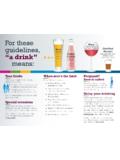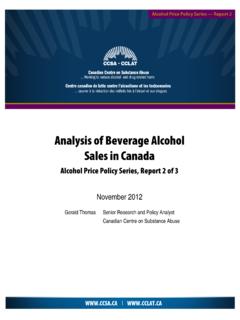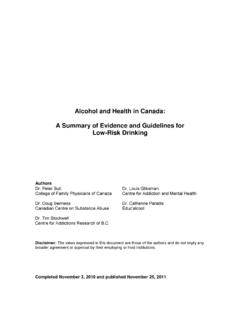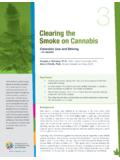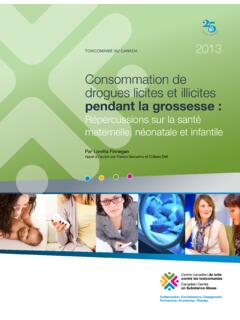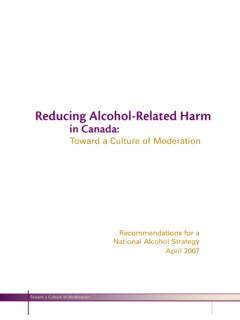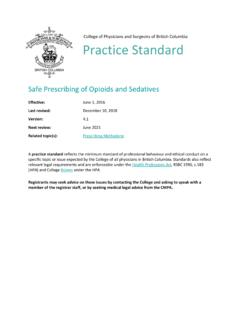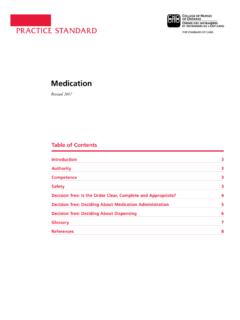Transcription of Prescription Opioids (Canadian Drug Summary)
1 September 2017 canadian drug summary canadian Centre on Substance Use and Addiction Centre canadien sur les d pendances et l usage de substances Page 1 Prescription Opioids Introduction Prescription Opioids are medications primarily used to treat acute and chronic pain, but they can also be used to control persistent cough or diarrhea. Another accepted medical use for Prescription Opioids is the treatment of opioid addiction, using methadone or buprenorphine-naloxone, under the supervision of a trained healthcare practitioner. Pain is one of the most common reasons for seeking health care in North America. A 2012 review indicated that between 15% and 29% of the canadian population experience chronic pain, with limited access to appropriate and timely treatment: 50% have had to wait six or more months and many areas of Canada do not have any specialist pain treatment Prescribers commonly use Prescription Opioids as one of several approaches to addressing chronic pain.
2 A 2017 report found that in the fiscal year 2015 2016, about one out of every seven people in Ontario (almost two million individuals) filled an opioid However, use of Prescription Opioids can also result in addiction and overdose death. In previous years, Prescription Opioids have been falsely promoted as low-risk, non-addictive, effective treatments for moderate The 2017 canadian Guideline for opioid Therapy and Chronic Non-Cancer Pain reports that Opioids are associated with a risk of addiction, and recommends optimizing non- opioid pharmacotherapy ( , nonsteroidal anti-inflammatory drugs) and non-pharmacological therapy over the use of Opioids for patients with chronic non-cancer The non-medical use of Prescription opioidsi has traditionally been defined as use by people other than those to whom the medication is prescribed or use in a manner or for a purpose contrary to what is intended.
3 There are various ways in which Prescription drugs can be acquired and used or can result in harm. These ways include obtaining a Prescription from a single physician, obtaining i For the purposes of this document, Prescription opioid use refers to use of Opioids as prescribed. Non-medical use of Prescription Opioids includes using Prescription Opioids without a Prescription written for the individual taking the drug , using Prescription Opioids provided from multiple doctors, nurses or pharmacists ( double-doctoring ), using them for purposes other than those indicated when prescribed ( , for euphoric effect), using them in ways other than prescribed (different form or route), or taking Prescription Opioids more or less often than prescribed. Key Points opioid pain relievers are used by 13% of the canadian population, compared to 15% in Among Canadians who use opioid pain relievers, about 2% reported using them for non-medical purposes, a similar percentage as in 2013.
4 The rate of hospitalization due to opioid poisoning has been increasing, with an average of 13 hospitalizations per day in 2014 2015, compared to an average of nine hospitalizations per day in 2007 2008. Preliminary data indicate that there were over 2,800 opioid -related deaths in Canada in 2016. canadian drug summary : Prescription Opioids canadian Centre on Substance Use and Addiction Centre canadien sur les d pendances et l usage de substances Page 2 Page 2 prescriptions from multiple physicians without informing them of the other prescriptions ( double doctoring ), Prescription fraud and forgery, theft, street drug markets and Internet purchases. A canadian study found that 37% of opioid -dependent patients admitted to the Centre for Addiction and Mental Health in Toronto reported receiving Opioids solely from physician prescriptions, compared to 26% of patients who received Opioids from both a Prescription and the street, and 21% from the Opioids are commonly referred to as pain killers or narcotics and have a variety of generic, trade and street names.
5 Table 1 lists examples of Prescription Opioids currently marketed in Canada. However, Prescription Opioids not currently marketed in Canada might be diverted into the country. Prescription Opioids are available in various forms in Canada, including tablets, capsules, syrups, solutions, liquid form for injection, skin patches, transmucosal preparations, suppositories and nasal sprays. Table 1. Common generic, trade and street names for Opioids Generic name Trade name (examples) Street names Buprenorphine BuTrans Bupe, bute Buprenorphine-naloxone Suboxone Subby, bupe, sobos Codeine Tylenol 2,3,4 (codeine + acetaminophen) Cody, captain cody, T1, T2, T3, T4 Fentanyl Abstral , Duragesic , Onsolis Patch, sticky, sticker, nerps, beans Hydrocodone Tussionex , Vicoprofen Hydro, vike Hydromorphone Dilaudid Juice, dillies, dust Meperidine Demerol Demmies Methadone Methadose , Metadol Meth, drink, done Morphine Doloral , Statex , M, morph, red rockets Oxycodone OxyNEO , Percocet , Oxycocet Percodan Oxy, hillbilly heroin, percs Pentazocine Talwin Ts Tapentadol Nucynta Unknown Tramadol Ultram Tramacet Tridural Durela Chill pills, ultras Note: OxyContin is no longer marketed in Canada and was replaced with OxyNEO.
6 Generic controlled-release oxycodone was approved by Health Canada. Oxymorphone (Opana ) has been approved by Health Canada, but is currently not marketed in Canada. Effects of Prescription opioid Use Opioids can reduce pain and improve function. Opioids can also produce a feeling of well-being or euphoria ( high ). At sufficiently high doses, Opioids cause drowsiness, respiratory depression, coma and death. Other physical effects are constricted pupils, nausea, vomiting, constipation, loss of appetite and sweating. Opioids can also cause increased risk of sleep apnea, mood changes, decreased sex hormone levels resulting in decreased interest in sex and menstrual irregularities, physical dependence and addiction. Regular use of large quantities of Opioids during pregnancy increases the risk of premature delivery and withdrawal in the infant. In those people who crush and inject oral Opioids , certain filler chemicals in the pills can permanently damage veins and organs.
7 Sharing needles or injecting with previously used needles greatly increases the risk of getting certain infections ( , HIV, hepatitis C). Long-term use can lead to the development of physical dependence, which manifests as tolerance to the effects of the drug and prompts those who use Prescription Opioids to increase the dose to reinstate the desired effects. Those who have developed a physical dependence can also experience withdrawal symptoms when the dose is lowered. The potential for addiction increases with repeated use of higher doses. Addiction to Opioids includes behaviours reflecting loss of control over use and significant harms from use, for example, which are usually in addition to physical dependence. Long-term regular use of these drugs should be reduced gradually with medical supervision. People who are physically dependent on Opioids might experience withdrawal symptoms if they stop using canadian drug summary : Prescription Opioids canadian Centre on Substance Use and Addiction Centre canadien sur les d pendances et l usage de substances Page 3 Page 3 the drug abruptly.
8 The severity of withdrawal symptoms depends on the type of medication used, the amount used, the duration of use and how abruptly the drug was discontinued. Withdrawal symptoms can include agitation, insomnia, muscle aches, abdominal cramping, diarrhea and vomiting. Those who are addicted might also experience craving for the drug and difficulty stopping. Legal Status of Prescription Opioids in Canada Most Prescription Opioids are classified as Schedule I drugs under the Controlled Drugs and Substances Act (CDSA). Their use is legal when they are prescribed by licenced practitioners and used by the person for whom they are prescribed. Illegal possession of Opioids and double doctoring ( , obtaining a Prescription from more than one practitioner without telling the prescribing practitioner about other prescriptions received in the past 30 days) can result in seven years imprisonment. Trafficking, importing, exporting or producing Opioids can result in life Past-Year Use of Prescription Opioids in Canada General population (age 15+): According to the 2015 canadian Tobacco, Alcohol and Drugs Survey (CTADS),7 the rate of past-year use of opioid pain relievers among the general population was , compared to in Youth (age 15 24): In 2015, the rate of past-year use of opioid pain relievers among youth aged 15 24 ( ) was lower than that of adults aged 25 and over ( ).
9 7 Among youth aged 15 19, the rate of past-year opioid pain reliever use was ; the corresponding rate was higher for young adults aged 20 24 at Adults (age 25+): The rate of opioid pain reliever use among canadian adults was in The use of opioid pain reliever medications among adults has decreased slightly from 2013, when reported using such Older Adults (age 65+): The rate of opioid pain reliever use among older canadian adults was in 2015, down from in Gender: Data from the 2015 CTADS indicates that the past-year prevalence of use of opioid pain relievers was slightly higher among females ( ) compared to males ( ).7 Similar trends were observed in 2013 ( for female and for males).8 ii This analysis is based on the Statistics Canada canadian Tobacco, Alcohol and Drugs Survey, 2015. All computations, use and interpretation of these data are entirely that of CCSA.
10 Iii This analysis is based on the Statistics Canada canadian Tobacco, Alcohol and Drugs Survey, 2015. All computations, use and interpretation of these data are entirely that of CCSA. iv This analysis is based on the Statistics Canada canadian Tobacco, Alcohol and Drugs Survey, 2013. All computations, use and interpretation of these data are entirely that of CCSA. canadian drug summary : Prescription Opioids canadian Centre on Substance Use and Addiction Centre canadien sur les d pendances et l usage de substances Page 4 Page 4 Figure 1. Prevalence of self-reported opioid pain reliever use among Canadians by age categoryv Source: CADUMS 2008 2012,9 CTADS 2013,8 CTADS 20157 Note: Because of methodological differences between canadian Alcohol and drug Use Monitoring Survey (CADUMS) and CTADS, comparisons of prevalence estimates between CADUMS (2008 2012) and CTADS (2013, 2015) data should be made with caution.
